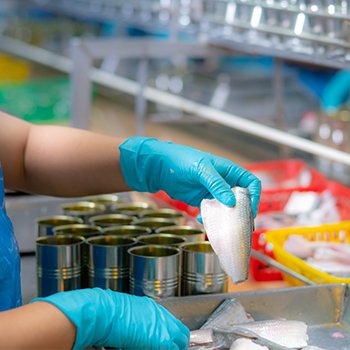ปรับปรุงผลิตภาพอุตสาหกรรมอาหารด้วยการสร้างมูลค่าเพิ่ม Enhancing Productivity in the Food Industry through Value Addition
248 Views |

ปรับปรุงผลิตภาพอุตสาหกรรมอาหารด้วยการสร้างมูลค่าเพิ่ม
Enhancing Productivity in the Food Industry through Value Addition
กฤชชัย อนรรฆมณี
Kritchai Anakamanee
Lean and Productivity Consultant
Kritchai.a@gmail.com
อุตสาหกรรมอาหารตามแนวทางครัวของโลก ถือเป็นกลุ่มอุตสาหกรรมที่มีความสำคัญกับประเทศเกษตรกรรม โดยเฉพาะประเทศไทยเป็นอย่างมาก ซึ่งในปี พ.ศ. 2566 ประเทศไทยมีรายได้จากการส่งออกอยู่ที่ประมาณ 1.55 ล้านล้านบาท หรือเพิ่มขึ้นร้อยละ 5.5 โดยส่วนแบ่งตลาดส่งออกของไทยเมื่อเปรียบเทียบกับทั่วโลกอยู่ที่ร้อยละ 2.47 เพิ่มขึ้นร้อยละ 2.25 จากปีก่อนหน้า ส่งผลให้ประเทศไทยขึ้นเป็นผู้นำส่งออกอันดับที่ 12 ของโลก (จากเดิมอยู่อันดับที่ 15 ของโลก) ดังนั้น การยกระดับผลิตภาพด้วยการสร้างมูลค่าเพิ่มอย่างต่อเนื่องจึงเป็นปัจจัยสำคัญ เพื่อรักษาความสามารถทางการแข่งขันและการเติบโตของธุรกิจในอนาคต
หลักการของผลิตภาพ
หลักการของผลิตภาพเป็นการมองภาพรวมของการผลิต โดยเริ่มจากปัจจัยการผลิต (Input) นำมาผ่านกระบวนการผลิต (Process) เพื่อให้ได้ออกมาเป็นผลลัพธ์หรือผลผลิต (Output) ตามที่ต้องการ โดยผลิตภาพวัดได้โดยการคำนวณอัตราส่วนระหว่างผลิตผล (Output) ต่อปัจจัยการผลิต (Input) ดังแสดงในสมการ (1) ในทางปฏิบัติ อัตราส่วนนี้อาจกลับด้านเป็น Input ต่อ Output ก็ได้
ลดความสูญเสียและต้นทุนในกระบวนการผลิต
เมื่อมูลค่าเพิ่มเกิดจากปัจจัยหลัก 2 ตัว คือ Input และ Output ดังนั้น การสร้างมูลค่าเพิ่มให้มากขึ้นจึงสามารถทำได้เป็น 2 แนวทาง ได้แก่ ลดความสูญเสีย/ต้นทุน (Waste/Cost reduction) และสร้างมูลค่า (Value creation) โดยวิธีลดต้นทุนเริ่มจากการใช้วัตถุดิบ (Input) ให้น้อยลง ตรวจสอบว่ามีความสูญเสียเกิดขึ้นที่จุดใดบ้าง เนื่องจากทรัพยากรอาจจะไม่ได้ถูกนำไปสร้างมูลค่าเพิ่มทั้งหมด และมักจะมีความสูญเสียในแต่ละช่วงของกระบวนการผลิตอยู่เสมอ โดยหลักการนี้สามารถเขียนได้ ดังแสดงในสมการ (2)
สร้างมูลค่าให้กับผลผลิต
อีกกลยุทธ์ คือ การทำให้ผลิตภัณฑ์หรือบริการมีมูลค่ามากขึ้น โดยใช้ทรัพยากรเท่าเดิมหรืออาจจะลงทุนกับทรัพยากรให้มากขึ้น เพื่อให้ผู้ผลิตได้ผลิตภัณฑ์กลับมาคุ้มค่าขึ้น ซึ่งมูลค่าที่มากขึ้นนี้เกิดขึ้นได้จากทั้งจำนวนที่มากขึ้นหรือคุณค่าที่เพิ่มขึ้น ในโลกปัจจุบันการพัฒนาความสามารถของเทคโนโลยีก้าวหน้าไปอย่างรวดเร็ว สวนทางกับต้นทุนที่มีแนวโน้มต่ำลงเรื่อยๆ จึงทำให้จุดคุ้มทุนในการนำเทคโนโลยีมาประยุกต์เข้าถึงได้ง่ายขึ้น แต่ในความเป็นจริงของธุรกิจ ระบบการผลิตจำเป็นจะต้องหาจุดสมดุลเพื่อออกแบบกระบวนการว่า ควรผลิตโดยใช้แรงงาน (Manual Operation) หรือผลิตแบบอัตโนมัติ หุ่นยนต์ หรือผลิตแบบผสม (Semi-Automation)
The "Kitchen of the World" concept underscores the critical role of the food industry in agricultural nations like Thailand. In 2023, Thailand's food exports reached a milestone, totaling THB 1.55 trillion, marking a 5.5 percent YoY increase and securing a 2.47 percent share of the global market, up by 2.25 percent from the previous year. This achievement propelled Thailand from 15th to 12th place among the world's leading exporters. The ongoing enhancement of the food industry's productivity, driven by value addition, is essential for Thailand's sustained competitiveness and economic growth.
Principle of Productivity
The concept of productivity is rooted in a macroscopic perspective of production, where inputs undergo processes to generate desired outputs. The resources employed in manufacturing, known as inputs, can be measured for productivity. This is often calculated by comparing the ratio of products to factors of production, as illustrated in the equation (1):
Loss and Cost Reduction in Production Processes
Added value hinges on two primary factors: input and output. Consequently, the generation of added value can be achieved through two methods: waste/cost reduction and value creation. The former entails minimizing input usage and identifying pivotal areas susceptible to losses. Unused ingredients represent missed opportunities to enhance added value, while certain stages are inherently more prone to losses. This concept can be encapsulated in the following equation (2):
Addition of Value to Products
Another value-adding strategy involves either maintaining the same input quantity or investing more in inputs to increase goods production. This added value can be achieved by scaling up either the quantity or the value of products. In the contemporary landscape, technology is advancing rapidly, albeit with technology costs trending downwards. Consequently, the break-even points for adopting new technologies are becoming more attainable. However, businesses must ensure that their production systems strike a balance between manual operation, automation, and semi-automation to remain competitive.






